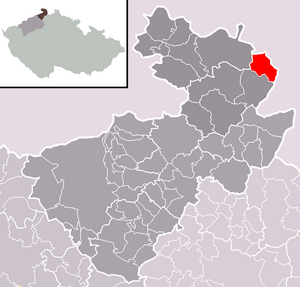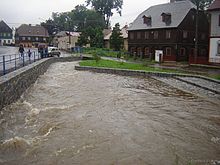Jiříkov
| Jiříkov | ||||
|---|---|---|---|---|
|
||||
| Basic data | ||||
| State : |
|
|||
| Region : | Ústecký kraj | |||
| District : | Děčín | |||
| Area : | 1331.0296 ha | |||
| Geographic location : | 51 ° 0 ′ N , 14 ° 34 ′ E | |||
| Height: | 368 m nm | |||
| Residents : | 3,640 (Jan 1, 2019) | |||
| Postal code : | 407 53 | |||
| License plate : | U | |||
| traffic | ||||
| Railway connection: | Bakov nad Jizerou – Ebersbach | |||
| structure | ||||
| Status: | city | |||
| Districts: | 4th | |||
| administration | ||||
| Mayor : | Michal Maják (as of 2018) | |||
| Address: | Náměstí 464 407 53 Jiříkov |
|||
| Municipality number: | 562581 | |||
| Website : | www.jirikov.cz | |||
| Location of Jiříkov in the Děčín district | ||||

|
||||
Jiříkov (German Georgswalde ) is a town in the Okres Děčín in the Czech Republic .
geography
Geographical location
The city is located in northern Bohemia in a flat valley surrounded by hills at 368 m nm near the border with Saxony , 5 km north of Rumburk ( Rumburg ). It stretches along the Ritterbach (Jiříkovský potok) in the Bohemian Netherlands and extends north-east to the Spree , which also forms the state border. The cadastral area is 1331 ha.
To the east rises the 485 m high Schlechteberg , to the north - also on German territory - the Hainberg (400 m).
Community structure
The town of Jiříkov is divided into the districts Filipov (Philippsdorf) , Loučné (Wiesenthal) , Nový Jiříkov (New Georgswalde) and Starý Jiříkov (Old Georgswalde) . Basic settlement units are Filipov, Jiříkov and Pod Vyhlídkou ( Am Butterberg ).
The municipality consists of the cadastral districts Filipov u Jiříkova and Jiříkov.
Neighboring places
| Neusalza-Spremberg | ||
| Šluknov (Schluckenau) |

|
Ebersbach-Neugersdorf |
| Rumburk (Rumburg) |
Direct neighbors are Haine in the north, Spreedorf in the east, Filipov and Neugersdorf in the southeast, Rumburk in the south and Království in the west.
history
Georgswalde was first mentioned in a document in 1346 in the registers of the Meissen diocese .
1524 held Reformation in which the basic rule Schluckenau associated village feeder. The Protestants had a wooden house of prayer here. As a result of the re-Catholicization , many families emigrated to the surrounding villages of Upper Lusatia from 1620 onwards . In 1725 Countess Ernestine von Harrach built the beautiful parish church of St. Georg. In addition to agriculture, linen weaving fed the residents of the village, which was elevated to a market town in 1756 by Empress Maria Theresa .
In the 19th century, the appearance of the town changed with the beginning of industrialization . In 1807 the first cotton spinning mill was established, which was later followed by two more, a loom factory and wood goods factories. Together with Rumburg , Georgswalde became the center of the North Bohemian textile industry. In 1873 rail traffic from Rumburg to Ebersbach / Sa. taken by the Bohemian Northern Railway . With this now continuous connection from Prague , which is the only railway line to Saxony over the Lusatian Mountains , the market town on the border offered ideal conditions for further industrial settlements. An iron foundry, mechanical engineering factory was established and the Saxon piano manufacturer August Förster also set up a branch in 1900. In 1890 there were 5,808 inhabitants in Alt Georgswalde, together with the districts of Neu Georgswalde, Philippsdorf and Wiesenthal there were a total of 8,754. In 1897 Philippsdorf became an independent municipality in the judicial district of Schluckenau .
In 1914 Georgswalde, whose population had grown to 10,084, was granted city rights by Franz Joseph I.
After the First World War , Georgswalde was added to the newly created Czechoslovakia . After the Munich Agreement Georg Walde belonged from 1938 to 1945 for the district of Rumburk , Region of Usti nad Labem , in the Reich District of Sudetenland the German Reich .
Expulsion of the German-speaking population: After the Second World War , the German-speaking population was expelled from Georgswalde . Her property was confiscated by Beneš Decree 108 and the Catholic Churches in Czechoslovakia expropriated . The Czech Republic made no compensation for the confiscated assets.
After the Velvet Revolution there was a change in the economic structure, and service and trading companies settled there. Today the city is home to a large group of Roma , the proportion of which is growing compared to the rest of the population. There were repeated conflicts.
In the city there is a rail border crossing to Ebersbach. For cars, the place has two border crossings to Neugersdorf (Hauptstrasse and Rudolf-Breitscheid-Strasse) and one to Ebersbach (Bahnhofstrasse).
Population development
Until 1945 Georgswalde was predominantly populated by German Bohemia , which were expelled.
| year | Residents | Remarks |
|---|---|---|
| 1830 | 4499 | in 805 houses |
| 1890 | 5808 | |
| 1900 | 7900 | of which 7890 (99%) Germans and ten Czechs, according to other data, 8132 German residents |
| 1921 | 7482 | 7095 (95%) of them are Germans |
| 1930 | 7970 | thereof 257 (3%) Czechs |
| 1939 | 7683 |
| year | 1970 | 1980 | 1991 | 2001 | 2003 |
|---|---|---|---|---|---|
| Residents | 3945 | 3905 | 3638 | 3920 | 3926 |
Town twinning
-
 Ebersbach / Sa. , Germany
Ebersbach / Sa. , Germany - Jiřikov (Georgswalde) is also a member of the cross-border communal association Fünfgemeinde , which was brought into being on October 19, 2000 in Šluknov (Schluckenau) by the mayors of five towns and communities on both sides of the German-Czech border . At the time, Neusalza-Spremberg , the then still independent Friedersdorf and Oppach from the German side and Šluknov and Jiříkov from the Czech side, united in the network of municipalities in the southern Upper Lusatia / Schluckenauer Zipfel border region . On May 10, 2008, the community of Sohland (Spree) was accepted into the five-community and on November 4, 2011 the twin town of Ebersbach-Neugersdorf .
Culture and sights
Buildings
- The baroque St. George's Church was built between 1724 and 1728 according to plans by Johann Lucas von Hildebrandt instead of a wooden predecessor, presumably by the master builder Johann Georg Achbauer the Elder. J. erected.
- The pilgrimage basilica Maria Hilf in Filipov , consecrated on October 11, 1886, was opened in 1926 by Pius XI. raised to the minor basilica . This was preceded by the "apparition of Mary" to Magdalena Kade in 1866.
Regular events
- Old Bohemian fair
- Fun fair in Filipov
Personalities
- Eduard Kindermann (1870–1945), crib builder and church painter
- Joseph A. Ruprecht (1895–1971), composer and church musician
- Karl Holfeld (1921–2009), painter and graphic artist
- Kordula Karolina Ulbrich , Abbess of St. Marienstern between 1874 and 1882
Web links
- City website (Czech)
- Private website about Jiříkov (Czech)
- Georgswalde - historical considerations
- Georgswalde Museum
Individual evidence
- ↑ Obec Jiříkov: Podrobné informace. In: Územně identifikační registr ČR. Retrieved September 1, 2014 (Czech).
- ↑ Český statistický úřad - The population of the Czech municipalities as of January 1, 2019 (PDF; 7.4 MiB)
- ↑ Části obcí. In: Územně identifikační registr ČR. Retrieved September 1, 2014 (Czech).
- ↑ Základní sídelní jednotky. In: Územně identifikační registr ČR. Retrieved September 1, 2014 (Czech).
- ↑ Katastrální území. In: Územně identifikační registr ČR. Retrieved September 1, 2014 (Czech).
- ↑ a b c d Johann Gottfried Sommer : The Kingdom of Bohemia . Volume 1: Leitmeritzer Kreis , Prague 1833, pp. 274–275, item 14).
- ^ Karl-Peter Schwarz: Roma in the Czech Republic: Dispute in the Zipfel , Frankfurter Allgemeine Zeitung, September 1, 2011.
- ↑ Yearbooks of the Bohemian Museum of Natural and Regional Studies, History, Art and Literature . Volume 2, Prague 1831, p. 197, point 5) below.
- ↑ Community encyclopedia of the kingdoms and states represented in the Reichsrat . Edited on the basis of the results of the census of December 31, 1900. IX Bohemia (Vienna 1904) p. 754.
- ^ Meyers Großes Konversations-Lexikon 6th edition, volume, Leipzig and Vienna 1909, page 617 .
- ^ Ernst Pfohl: Ortlexikon Sudetenland. Page 142. Helmut Preußler Verlag-Nürnberg. 1987. ISBN 3-925362-47-9
- ^ Rudolf Hemmerle : Sudetenland Lexikon Volume 4, page 163. Adam Kraft Verlag, 1985. ISBN 3-8083-1163-0 .
- ^ A b Michael Rademacher: German administrative history from the unification of the empire in 1871 to the reunification in 1990. Rumburg district. (Online material for the dissertation, Osnabrück 2006).
- ↑ Czeski Urząd Statystyczny



